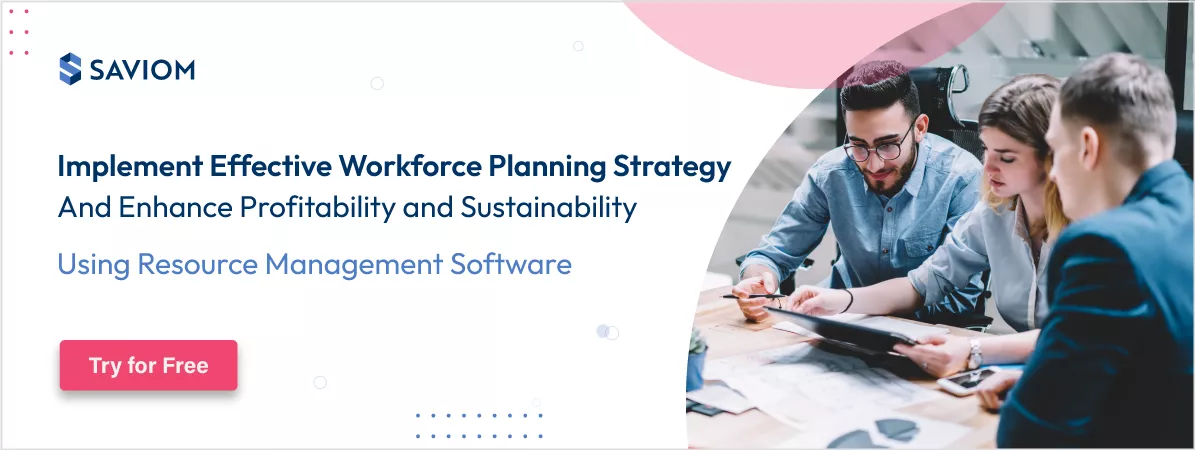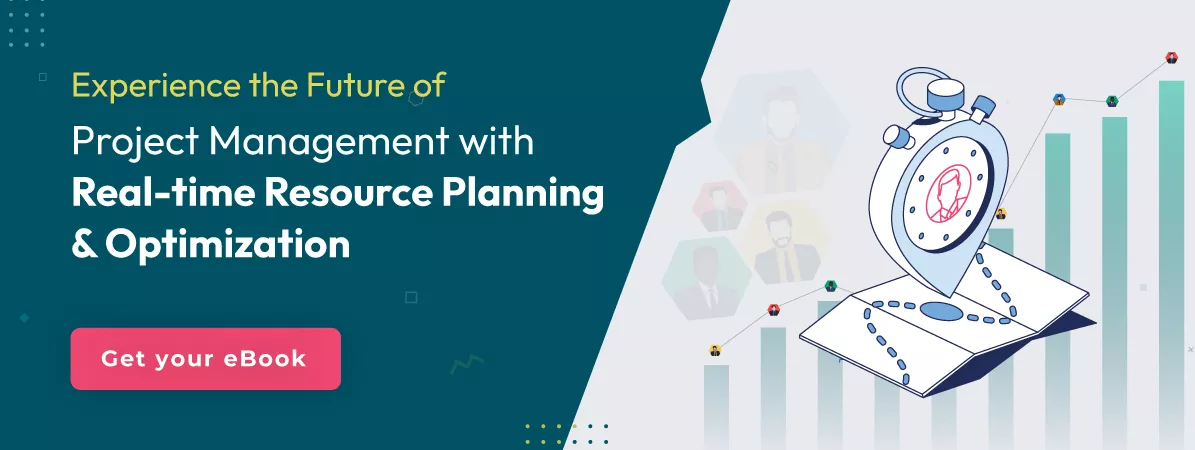What do you think determines a business’s sustainability and growth?
Some of the KPIs include annual recurring revenue, profit margins, client retention rates, and more.
While these indicators are undeniably pivotal, another crucial factor people often overlook is workforce planning. It involves determining the current workforce’s capacity and skills, identifying future resource requirements, finding skill gaps, and proactively implementing measures to fill them.
Creating an efficient planning strategy is imperative for every organization to control resourcing costs, drive profitability, and make the workforce future-ready.
However, in the absence of it, a company may face widening skill gaps, reduced profit margins, and lost business opportunities.
This blog talks about the role of workforce planning in a company and highlights some tell-tale signs that indicate your company doesn’t have a robust strategy in place.
So, let’s get started.
How does workforce planning impact an organization?
As a significant portion of revenue is spent on hiring, training, and paying salaries to the workforce, it’s imperative to utilize them effectively and unleash their true potential. An effective workforce planning strategy helps identify an organization’s current and future staffing needs. In addition, it helps create a plan to bridge the capacity vs. demand gap and ensure the right resource is allocated to the right job at the right time and cost.
Besides, it enables organizations to stay forewarned and mitigate resource-related risks due to constantly changing demands in a competitive and volatile market. Secondly, it provides managers with enough lead time to hire the right mix of cost-effective resources and do succession planning for the future.
Without proper operational and strategic workforce planning, organizations can face high turnover, employee disengagement, poor quality deliverables, and other such consequences. Moreover, in the long run, they will lose their credibility and market reputation, failing to attract top talent and stunted growth.
Unfortunately, many organizations fail to implement an effective workforce planning strategy. For better understanding, we have listed some telltale signs that indicate your organization lacks a proper workforce planning strategy.
9 Signs of a poor workforce planning strategy
Enlisted below are the signs that show your organization needs to revisit your workforce plan to manage resource-related bottlenecks.
Frequent mismatch between demand and supply
The inability to assess the existing workforce capacity against future demand can cause a failure to initiate the right resourcing measures and bridge gaps proactively. This further leads to a misalignment between supply and demand. If continued for a long, it is a clear indication that the management lacks a robust workforce planning strategy. Moreover, it also leads to consequences like subpar deliverable quality, poor customer relations, budget/time overruns, and eventually results in loss of business.
Multiple hiring/firing cycles
SHRM reveals that firing an employee can cost employers up to 200% of the employee’s annual pay.
In the absence of forecasting capabilities, organizations rely on guesstimates for resource planning. In turn, it can lead to frequent and expensive hiring/firing cycles, which indicates that the company’s workforce planning is not efficient. For instance, if you hire a permanent niche skilled resource for a one-time assignment, it will be difficult to find suitable opportunities after the project finishes. So, the firm will have no option but to let go of the resource. Later, when there is a requirement for a similar skillset, the organization has to resort to expensive hiring for this niche-skilled resource. This constant hiring/firing cycle in the long term affects a firm’s profitability and reputation.
Read More: How Resource Management Helps in Reducing the Hiring/Firing Cycle?
Increase in bench time for several resources
During project ramp-down, if resources frequently spend bench time due to a lack of suitable work, it depicts there is no proper workforce planning strategy. Factors like a lack of foresight into future demand, inability to schedule them for future appropriate tasks in advance, hiring of incompetent employees, etc., can cause a sudden increase in bench size. If not addressed, it can disengage benched employees, cause unplanned attrition and impact the company’s overall profitability and sustainability.
Constant firefighting during peak season
Failure to forecast upcoming ramp-up activities and future demands during the peak season can cause last-minute firefighting, especially for the niche-skilled workforce. If this situation persists, it clearly signals a poor workforce planning strategy. This can lead to wrongful and expensive hiring, compromised quality of deliverables, and other consequences. This can impact the overall financial health of the business. If such signs persist long-term, a company won’t stay sustainable.
Read More: How to Balance Ramp-Ups and Ramp-Downs in a Project?
Project delays due to wrongful hiring of global resources
If a company constantly struggles/fails to deliver projects on time, it can jeopardize the recurring business from existing clients, adversely impacting future growth. When an organization witnesses such signs, it can be due to improper workforce planning strategy, resulting in wrongful hiring and allocation of resources. For instance, if a company hires less competent employees from low-cost locations and allocates them to critical tasks, it will affect the project workflow. This can also lead to sub-par deliverables quality, low customer satisfaction, reduced recurring revenue, and loss of business.
Surge in unplanned attrition
If you witness that the turnover rates for a business are growing at an alarming rate, it is a sign of an ineffective workforce plan. This can be due to multiple factors. First, if work allocation is beyond a resource’s capacity, it can cause stress and burnout. Second, if an employee is not allocated to work matching their skill sets, it can result in lower employee morale and engagement. In either case, the employees may look for better opportunities outside the organization and contribute to increased unplanned attrition.
Low employee morale and engagement
A recent survey reveals that it is becoming increasingly difficult for senior management in global companies to keep their employees engaged.
A lack of suitable upskilling/training opportunities, uneven workload distribution causing under/over utilization, etc., can reduce employee engagement and morale. If this situation arises often, it is a strong indicator of a firm’s inability to create a robust workforce planning strategy. This can adversely affect overall productivity and the bottom line.
Read More: 11 Effective Strategies to Enhance Employee Engagement
Missed opportunities for business growth
Inaccurate estimation of skillsets required to future-proof the workforce against market volatility and evolving trends and technology demands can make a company miss out on several billable opportunities. Moreover, frequent hiring/firing or layoffs can further worsen the situation. If frequent and persistent, it clearly signals the need to rethink and strengthen the company’s workforce planning strategy. This can help avoid shrinking revenue, reduced client base, and increased unplanned attritions, etc.
Misalignment between long-term strategy and execution
Organizations often lack clarity on the types of resources required to fulfill their long-term vision and end up fulfilling workforce demands only for immediate goals and day-to-day objectives. This indicates that a company doesn’t have robust workforce planning in place. As a result, managers can find it challenging to execute succession planning, formulate suitable training programs, and prioritize work to help firms achieve long-term vision and goals.
If you witness any of the above signs in your company, then it’s time to create an effective workforce planning strategy.
Let’s understand how:
How to create an effective workforce planning strategy?
Every organization adopts a unique approach for workforce planning based on its business model and requirements. However, here are a few proven practices you can follow to create an efficient workforce planning strategy.
Set clear long-term goals
While most organizations manage to tackle day-to-day activities and meet short-term goals, they struggle with creating a long-term vision. However, a strategic vision is essential to help the company sustain in the long run. So, one should begin with defining SMART (Specific, Measurable, Attainable, Relevant, and Time-bound) goals and objectives.
Further, before creating and finalizing a detailed plan, the leadership must also check and ensure that the established goals align with the company’s values. It will help identify strategic areas and make the business goals more realistic and achievable.
Read More: 7 Top Business Benefits of Strategic Workforce Planning
Asses the existing workforce
Once the strategic goals are established, the next step in workforce planning is analyzing the organization’s existing workforce and skill demands. This will enable management to analyze and determine the quantity and quality of the workforce and the skills needed to achieve long-term goals.
Accordingly, the company can implement suitable training and reskilling measures, create individual development programs (IDPs), and improvise the overall hiring strategy to fulfill current and future demands.
Foresee resource shortage in advance
Based on the evaluation of the current talent pool, the company can assess the current and future skill shortages caused due to retirement of certain employees or evolving technologies. Accordingly, they can implement suitable internal or external resourcing channels to bridge skill gaps proactively.
Moreover, if a company doesn’t have people with requisite skills at all, it can hire them on a permanent or contingent basis as appropriate or create a judicious mix of both. The hiring decision can be made in accordance with the short-term and long-term assignments and demands.
Plan and adapt to change
The global business landscape is evolving rapidly and witnessing evolving market demands, changing customers’ preferences, technology advancement and automation replacing human jobs, and so on. So, along with determining how to bridge future skill gaps, firms must also be prepared for industry-specific developments, unexpected scenarios, or even a global recess.
For instance, they should implement proactive upskilling and reskilling programs to keep the existing workforce relevant. This can help them avoid large-scale layoffs and attrition in the near future.
Get advisors and stakeholders onboard
While finalizing the workforce planning strategy, discussing it with stakeholders like the CEO, the board of directors, and other senior management personnel is imperative. Large organizations can also hire a consultant specializing in a specific industry to assist in strategic planning.
Moreover, creating a weekly status report to inform the stakeholders of the daily progress on key aspects can be a good idea. Further, it should be ensured that suggestions given by stakeholders are considered and incorporated if deemed fit.
Read More: Who are Project Stakeholders and How to Manage Them Efficiently?
Constantly monitor your plan
Once your strategic plan is ready and implemented, the last ongoing step is continuously monitoring and ensuring it does not get derailed. Deciding on key performance indicators in terms of timelines, budget, clients acquired, milestones, and growth percentage can help track the plan.
Furthermore, the leadership must consider ever-evolving market conditions, customers’ preferences, seasonal fluctuations, and other factors to make amends accordingly and keep the plan relevant. If any roadblocks are faced in meeting KPIs, managers must take suitable measures to eliminate them and keep the plan on the right track.
So, it is evident that one can create an efficient workforce planning strategy by following the proven steps discussed above.
The following section explains how a resource management solution can contribute to a robust workforce plan.
How can resource management software help?
Advanced resource management solution can help organizations in creating effective workforce planning. The tool offers real-time insights into the pipeline projects’ demands through vacancy reports. In addition, the resource capacity planning feature of the tool helps foresee excesses or shortages ahead of time so that managers can take proactive measures to bridge the gap.
The automated resource requisition workflow process helps bridge communication gaps and maintains an audit trail to avoid scheduling conflicts. Moreover, the 360-degree visibility of the tool provides information about the workforce’s attributes like skills, competencies, qualifications, and availability. As a result, it helps managers allocate resources effectively and create individual development programs.
This enables them to keep them future-ready and engaged, thereby avoiding last-minute fire-fighting and high-cost hiring of the resources. Additionally, insights into future project demands and their nature help them to create the right mix of permanent and contingent employees. This helps to reduce overhead costs and meet short-term and long-term business goals.
Conclusion
Workforce planning forms a cornerstone of a successful business and is the key to staying profitable. So, every organization must ensure to make it effective and efficient. The points mentioned above will help managers identify the signs of poor workforce planning and implement ways to course-correct the same. This can also help you gain a competitive edge and enhance the firm’s bottom line.
So, does your organization have an effective workforce planning strategy?
The Glossary
Read More: Glossary of Resource Workforce Planning, Scheduling and Management
The SAVIOM Solution
SAVIOM is the market leader in helping multinational clients manage their resources efficiently and effectively. With over 20 years of experience, this Australian-based MNC has a global presence across 50 countries and has helped 100+ clients with their Workforce Planning Software. Saviom also provides tools for Enterprise Project Resource Management, Project Portfolio Management, and Professional Service Automation. Boost your remote team collaboration with Saviom.











